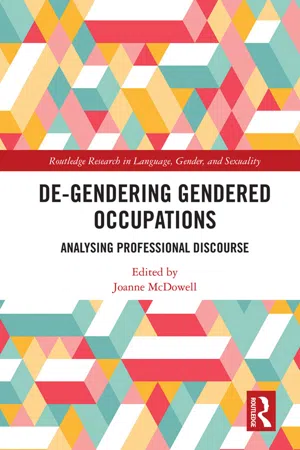
- 224 pages
- English
- ePUB (mobile friendly)
- Available on iOS & Android
About this book
De-Gendering Gendered Occupations brings together contributions from researchers on language and gender studies and workplace discourse to unpack and challenge hegemonic gendered norms encoded in what are traditionally considered female occupations. The volume integrates a range of theoretical frameworks, including conversation analysis, pragmatics, and interactional sociolinguistics, to analyse data from such professions as primary education, healthcare, and speech and language therapy across various geographic contexts. Through this lens, the first part of the book examines men's linguistic practices with the second part offering a comparative analysis of 'male' and 'female' discourse. The settings discussed here allow readers to gain insights into the ways in which cultural, professional, and gendered identity intersect for practitioners in these professions and in turn, future implications for discourse around gendered professions more generally. This book will be key reading for students and researchers in sociolinguistics, discourse analysis, gender studies, cultural studies, and professional discourse.
Frequently asked questions
- Essential is ideal for learners and professionals who enjoy exploring a wide range of subjects. Access the Essential Library with 800,000+ trusted titles and best-sellers across business, personal growth, and the humanities. Includes unlimited reading time and Standard Read Aloud voice.
- Complete: Perfect for advanced learners and researchers needing full, unrestricted access. Unlock 1.4M+ books across hundreds of subjects, including academic and specialized titles. The Complete Plan also includes advanced features like Premium Read Aloud and Research Assistant.
Please note we cannot support devices running on iOS 13 and Android 7 or earlier. Learn more about using the app.
Information
Table of contents
- Cover
- Half Title
- Title Page
- Copyright Page
- Dedication Page
- Contents
- List of Tables
- List of Figures
- Conventions Used
- Acknowledgements
- List of Contributors
- Part One
- Part Two
- Index